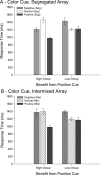Evidence for negative feature guidance in visual search is explained by spatial recoding
- PMID: 26191616
- PMCID: PMC4586389
- DOI: 10.1037/xhp0000109
Evidence for negative feature guidance in visual search is explained by spatial recoding
Abstract
Theories of attention and visual search explain how attention is guided toward objects with known target features. But can attention be directed away from objects with a feature known to be associated only with distractors? Most studies have found that the demand to maintain the to-be-avoided feature in visual working memory biases attention toward matching objects rather than away from them. In contrast, Arita, Carlisle, and Woodman (2012) claimed that attention can be configured to selectively avoid objects that match a cued distractor color, and they reported evidence that this type of negative cue generates search benefits. However, the colors of the search array items in Arita et al. (2012) were segregated by hemifield (e.g., blue items on the left, red on the right), which allowed for a strategy of translating the feature-cue information into a simple spatial template (e.g., avoid right, or attend left). In the present study, we replicated the negative cue benefit using the Arita et al. (2012), method (albeit within a subset of participants who reliably used the color cues to guide attention). Then, we eliminated the benefit by using search arrays that could not be grouped by hemifield. Our results suggest that feature-guided avoidance is implemented only indirectly, in this case by translating feature-cue information into a spatial template.
(c) 2015 APA, all rights reserved).
Figures








References
-
- Bundesen C. A theory of visual attention. Psychol Rev. 1990;97(4):523–547. Retrieved from http://www.ncbi.nlm.nih.gov/pubmed/2247540. - PubMed
-
- Desimone R, Duncan J. Neural mechanisms of selective visual attention. Annu Rev Neurosci. 1995;18:193–222. doi:10.1146/annurev.ne.18.030195.001205. - PubMed
-
- Downing P, Dodds C. Competition in visual working memory for control of search. Visual Cognition. 2004;11(6):689–703. doi:10.1080/13506280344000446.
Publication types
MeSH terms
Grants and funding
LinkOut - more resources
Full Text Sources
Other Literature Sources

